We’ve seen several high-scoring teams after nine fixtures across EFL leagues in the 2023/24 season. We’ve had Barnsley setting the bar early in League One by scoring 20 times in those nine games and Swindon Town leading the way in League Two with an astonishing 24 goals in eight games. Still, we’ve also seen the polar opposite in a few teams, but one in particular – Cheltenham Town.
The Robins started the season with former Championship player Wade Elliot in charge, with the ex-wide midfielder joining the club at the end of the 2021/22 season. Last season, Elliot guided Cheltenham to finishing 16th in League One – a respectable effort in a tough league. This season, after eight games, Elliot was dismissed with a horrific start to the campaign – seven defeats, one draw, zero wins, and perhaps the most shocking – zero goals scored. Their luck hasn’t changed under caretaker manager Kevin Russell (Assistant manager under Elliot), as the club suffered a 3-0 defeat at home to Stevenage. The search for the club’s next permanent manager is still ongoing.
This scout report will look at Cheltenham’s various attacking statistics to identify any glimmer of hope – any positives in attack that could be of use to the club’s next gaffer as they look to start scoring goals. The analysis will look at both team and individual data while assessing their weak areas in attack and a tactical analysis of any promising elements of their play.
The numbers behind their goalless form
Considering their current managerial situation, there is little point in diving into the deep details of Cheltenham’s attacking tactics. Instead, the aim here is to look at the areas where Cheltenham really struggled to try and highlight the areas the new manager will need to improve upon. From their performance at the end of attacking moves to the statistics behind their earlier possession phases, several data points help us understand why they find themselves in the place they are.
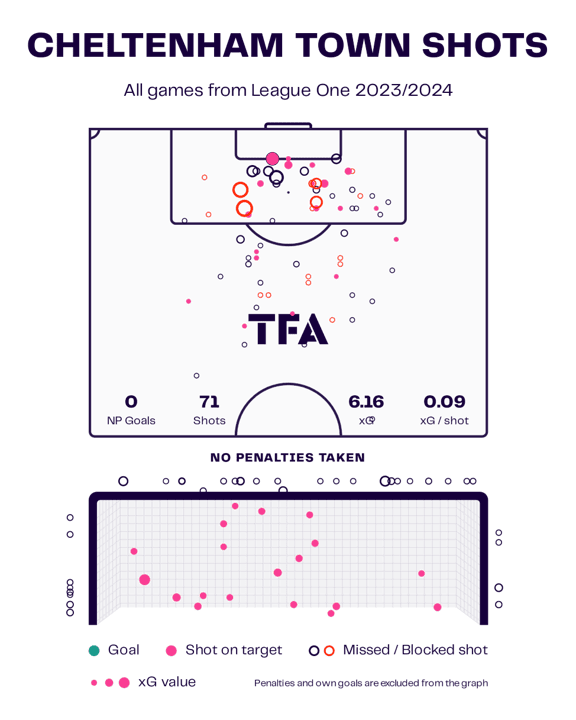
Looking at their xG map, part of the problem already starts to reveal itself. An xG register of 6.19 suggests that Cheltenham have gotten themselves into good attacking positions on occasions but just haven’t been able to finish chances off – but the chances themselves weren’t of high quality in terms of xG value. Their xG register is currently the lowest in the division, so carving out better chances on goal inside the box is a must – the same can be said of their need to take more shots in general, as they rank lowest for both shots per 90 (6.78) and shot accuracy (26.8%).
Another issue in their attacking tactics is the tendency to take unnecessary shots from range – the majority of their long shots have been off target, with a good chunk of them being the wrong decision, which is mirrored in the example below.
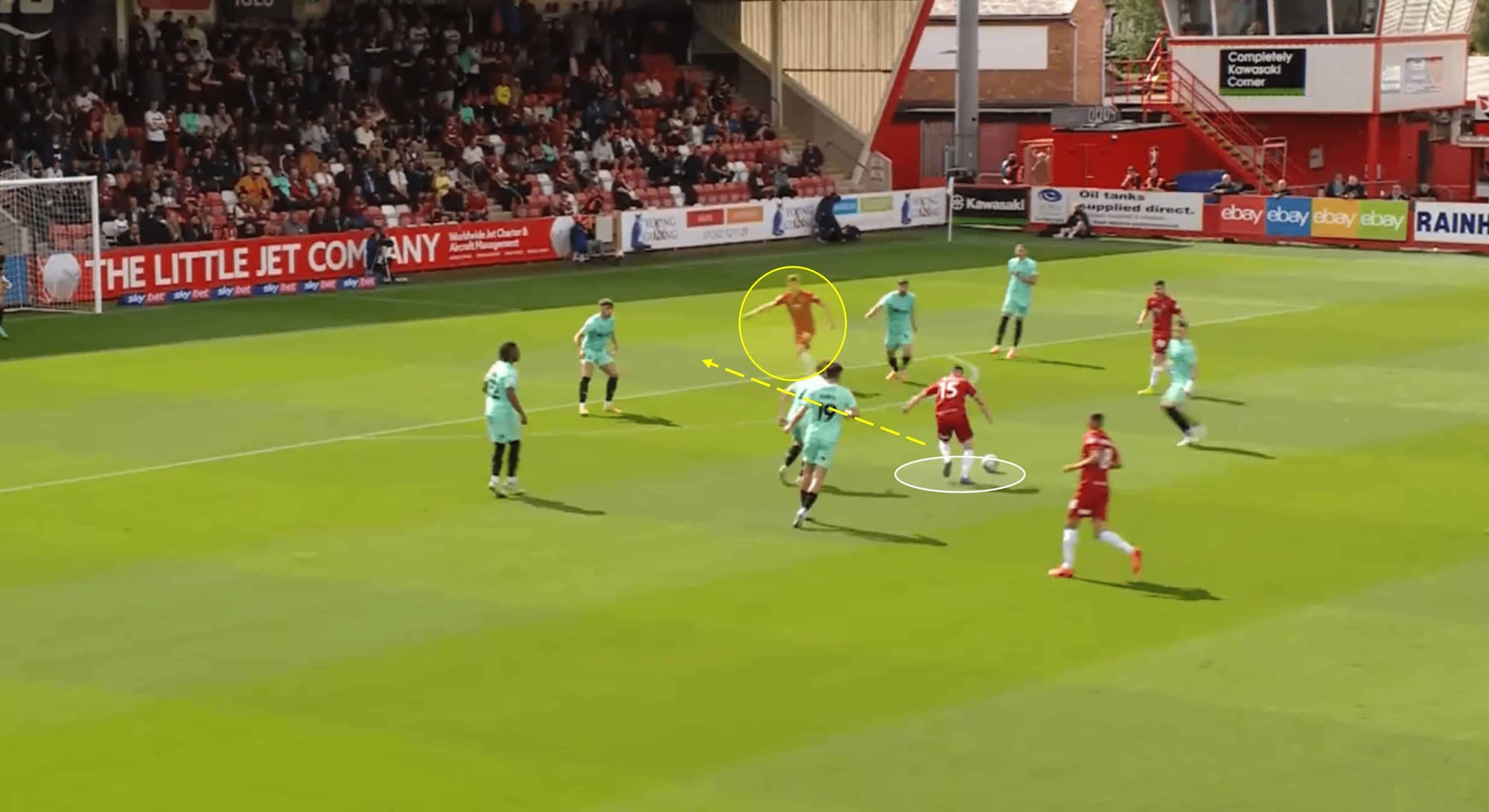
Will Ferry is the player on the ball in a promising central area, with a Robins forward making a good run in behind the opposition defence – the yellow passing line on the image represents the pass the midfielder should have made. Ferry either ignored this option or simply didn’t lift his head to see the run and instead opted for a wild effort from range that was nowhere near the target. Decision-making needs to improve in Cheltenham’s attacking approach play, and this is a prime example of that. This could be a matter of low confidence as the Robins currently have the lowest accuracy for through balls (17.1%).

As we touched upon previously, Cheltenham’s chance creation needs to improve. They seem to have a tendency to target their attacks down the right flank (more on that later), with far more deliveries coming from that side of the pitch and not many chances being created from other areas. They can’t exactly afford to be picky about the origin of their chance creation, though, as they currently have the lowest average possession in the entire league.
Areas of promise
All bad patches of form must end at some point, and morale is likely low around the club. Most Cheltenham fans are probably asking themselves the same question – where will that first goal come from? Well, in this segment of analysis, we will uncover some of the areas where the Robins have shown some promise and, thus, areas where the data suggests they could grab that all-important goal. While it is true that a lot of the good and bad data will partially reflect Elliot’s tactical approach, the new manager will want to draw on the squad’s current strengths, particularly in their early days at the helm.
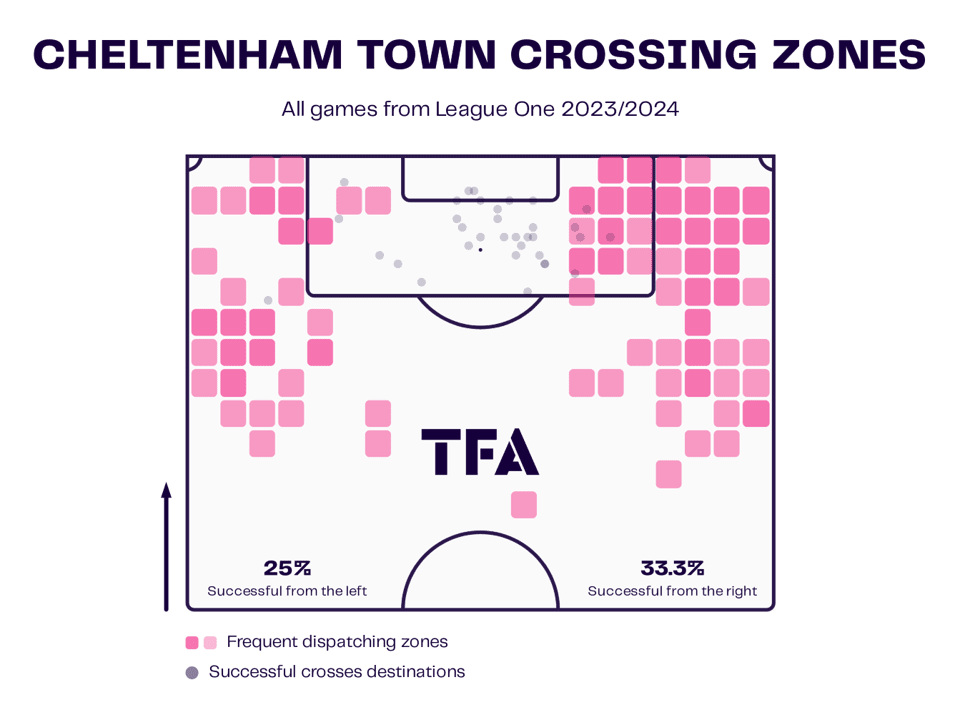
The visual above confirms our previous point about Cheltenham targeting a large portion of their attacks down the right flank. Not only do they cross more frequently from the right side, but they also find more success there, too. While they do have some good chemistry and cohesion down that side, as the next image shows, they may want to look into utilising the left side and the centre to a more significant effect.
Interestingly, while the Robins do currently rank third lowest for crosses per 90, they rank just below the midway point in terms of crossing accuracy – looking to make wing-play an essential element of their tactics may go a long way, significantly if they can boost their average possession.
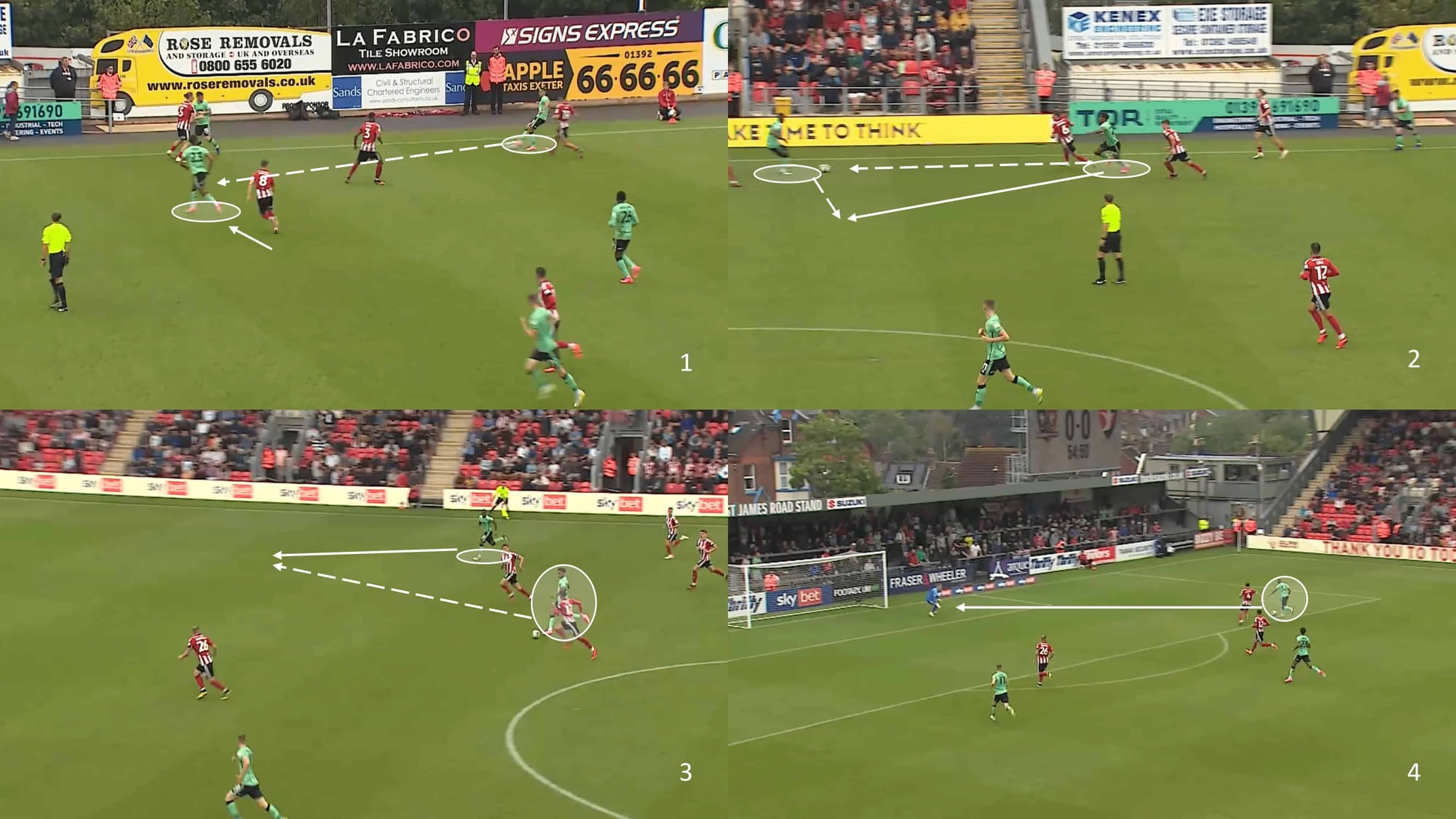
The four-part image above shows an example of Cheltenham creating a good chance on goal after an impressive piece of play down the right flank, which started in their own half. With good individual movement, timing of passes, and visible teamwork & cohesion, they were able to execute an effective passing combination that carved the opposition open.
Of course, they were unable to finish the chance off, but if they could create more opportunities in this fashion down both flanks, they would become a more dangerous team in the final third.
The above suggestion is, of course, easier said than done, especially considering some of Cheltenham’s struggles in possession – with the fourth-lowest pass accuracy in the entire league (74.1%) and third-lowest for both passes to the final third per 90 & accuracy, they clearly have an issue in maintaining an attack without losing the ball easily. To fix this, the new manager will likely want to look at the individual roles of his players in possession, particularly the midfielders.
In terms of positive numbers for passing, goalkeeper Luke Southwood has showcased his distribution ability, as evidenced by his 15.67 long passes per 90, which is the sixth-highest in the entire division. This is combined with his accuracy rate of 67.07%, which is the 12th highest in the league.
Meanwhile, defender Lewis Freestone has also demonstrated his long passing ability, ranking in the top 25 for the whole league thanks to his accuracy rate of 61.54%. Utilising these talents could be critical to the Robins’ tactics as they are highly unlikely to become a team that dominates possession, regardless of which manager comes through the door.
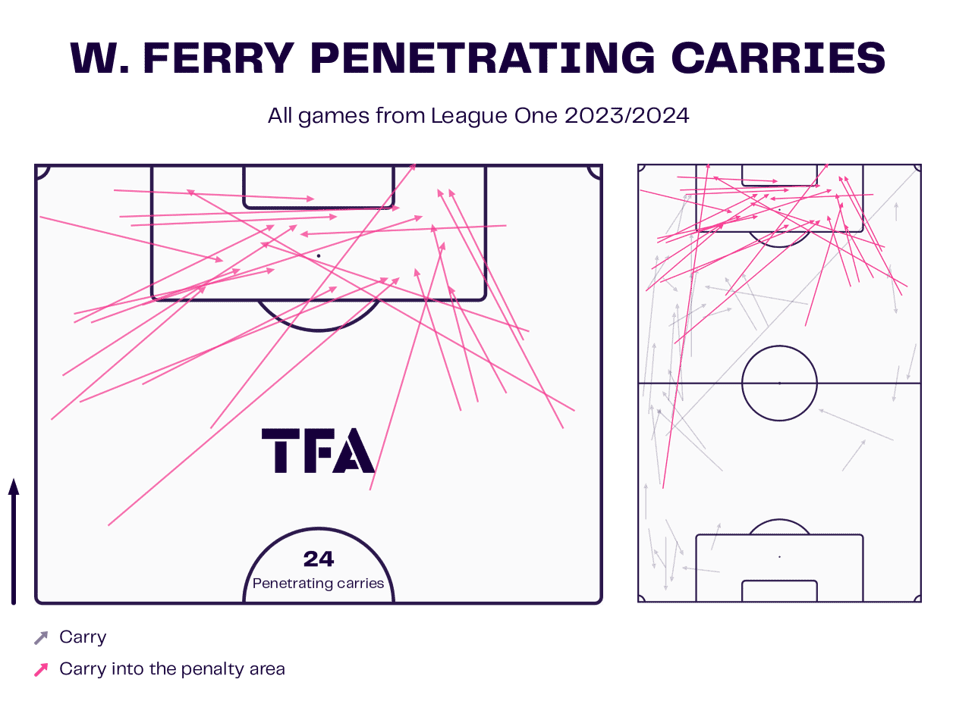
According to the data, 1v1s and dribbling have been one of the more positive aspects of Cheltenham’s play. While they rank the lowest for dribble attempts per 90 with 14.62, they boast the 13th-highest success rate, indicating some talent in this area, and should perhaps be utilised more often.
As you can see above, certain players have been particularly effective in this sense, including Will Ferry. 24 penetrating carries so far this season indicates a good level of technical ability and attacking aggression. His dribbling, in general, not just when entering the box, has been positive and effective.
Former Arsenal youngster James Olayinka has also demonstrated some good dribbling ability this season regarding both attempts and success. He is likely to be an essential player for the new boss once he returns from injury. Another player who has impressed in this area is Robert Street – more on him below.
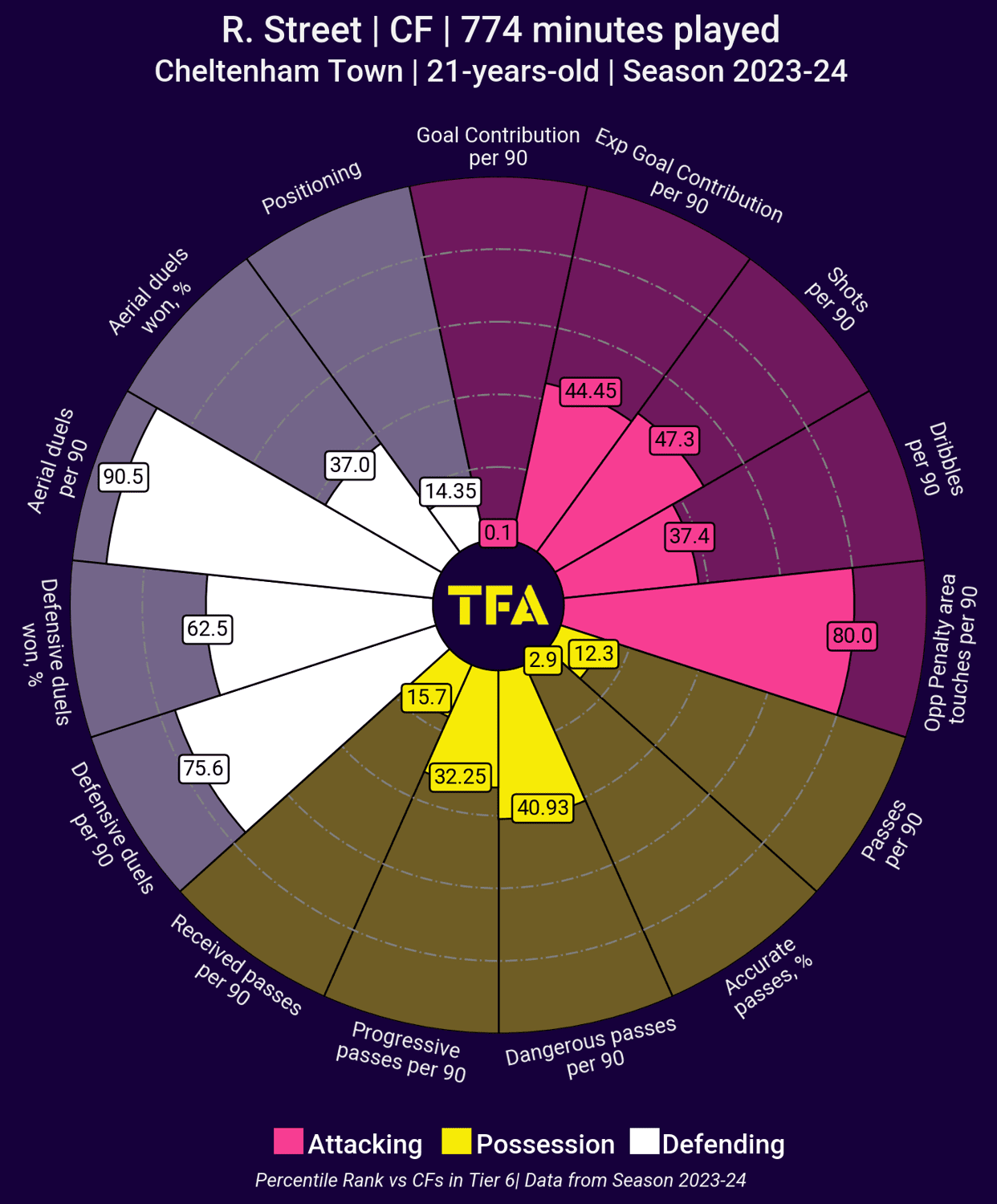
Street has shown some promise this season, which may sound counterintuitive for a striker in a team that is goalless in nine games, but his play has had plenty of positive aspects. The graph above showcases his data in a percentile rank format compared to other plays in tier 6 (tier 6 leagues include a variety of leagues worldwide, such as the A-League, the Canadian Premier League, the Slovakian Superliga, and many more).
It is expected that Street ranks low in several of the metrics due to his team’s struggles, but he has posted some data that suggests he could be of high importance to Cheltenham’s attack throughout the season. He has showcased his strength in several departments – decent showings in defensive duels per 90 & won indicate good aggression and physicality.
At the same time, he is not afraid of getting involved in an aerial duel, where he can offer a threat if the service is sufficient. He also has a high percentile rank for touches in the penalty area, which is both exciting and impressive, considering his side have one of the lowest rates in the league for this metric. This indicates that Street has good awareness and movement to consistently get involved in the box.
Conclusion
The question was simple. Where will Cheltenham’s first goal come from? Well, if the data we have presented is to be of any importance going forward, they aren’t going to get many goals where the attack consists of a high number of ground passes in a possession-based attack. Instead, they are likely to score from an attack on the right flank – thanks to intelligent combination play in transition, effective long passing from Southwood or Freestone at the back, or even some impressive individual dribbling from one of the mentioned individuals. Once they successfully reach the final third, striker Robert Street will likely be involved in the box, either providing a necessary touch/pass in the move or finishing the move off by getting his head on the end of a cross.
Of course, that first goal could come after the arrival of the new manager and the implementation of their own tactics, so Cheltenham’s approach could be altered entirely. Still, the data we have discussed has highlighted some critical parts of their current play.

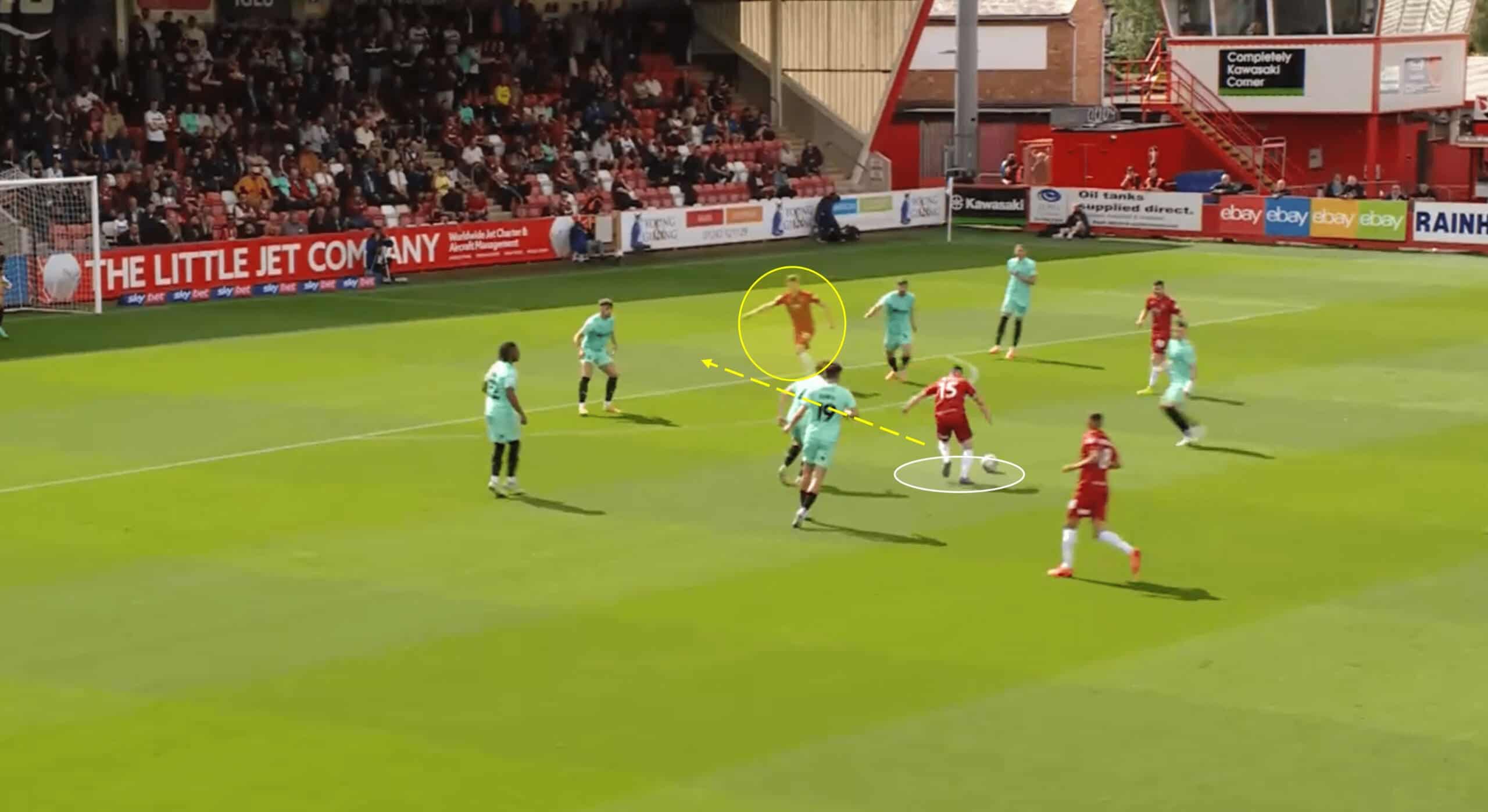




Comments